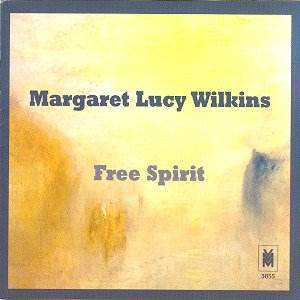I
must confess that Margaret Lucy Wilkins’ name and music are new
to me, so that a composer’s portrait, such as the present release,
is most welcome. It allows a fairly comprehensive survey of her
multi-faceted compositional skills. The works here are quite contrasted
though a closer study of the scores might, I suspect, help find
some common characteristics. The pieces date from different periods
of Wilkins’ composing career. The earliest piece is Struwwelpeter
for mezzo-soprano and ensemble dating from 1973. The music is
closely knit to fit the various moods implied by the texts. By
the way, "the original German text is by Dr. Heinrich Hoffmann
in an adaptation of an English translation". I do not know
why (and do not ask me why), but I suspect that the words might
be by the composer herself! Anyway, these texts have an underlying
theme: cruelty, to oneself and to others. Most texts have an ironic,
even sarcastic ring that is very adroitly reflected in the music.
Struwwelpeter, the first section, is about a "19th
century Shockheaded Peter" and his modern counterpart, the
drug addict. Cruel Frederick too is about cruelty, "not
least in the army". The third section, one of the longest,
Harriet and the Matches, is about the use of flame, when
a single flame gets out of control, which may have horrifying
results, "as was discovered in the Nazi concentration camps".
In her notes, the composer mentions that captive Jews were entertained(!)
by Offenbach’s celebrated Barcarolle. Hence, the lavish
use made of this tune in this otherwise gruesome section. Augustus
"starves to death in a land of plenty, through his own perverseness".
The setting sounds as a British folk-song gone sour. The Inky
Boys is about racial discrimination. It quotes the old South
African National Anthem played on an out-of-tune piano and the
rest of the music in this section has a jazzy tinge enhanced by
an all-pervading saxophone part. Flying Robert or how aviation
may also be used to drop other things than cereal bags. What about
the music, then? Well, overtly expressionistic, with distorted
but telling musical quotes or allusions, much in the same way
as Maxwell Davies in some of his music-theatre pieces. Incidentally,
Struwwelpeter was written for Jane Manning and Matrix.
Burnt
Sienna: Etude for String Trio is a beautiful essay in
string writing; and, to my mind, the most readily approachable
work in this cross-section of Wilkins’ output. 366"
for solo trombone is a free fantasy including some discrete music-theatre
techniques (the player is heard tapping his feet on the floor)
but, on the whole, I found it a more engaging work than Berio’s
Sequenza V.
Musica
Angelorum for string orchestra is another study in string
writing and, in every respect, as successful and attractive as
Burnt Sienna. Many arresting moments in this atmospheric
piece that vastly repays repeated hearings.
Wilkins’
large-scale symphony is by far the most substantial work here.
It was composed in 1989 but was first performed ten years later
by the same performers as on this disc. (The recording was actually
made a few months after the premiere.) It is in three movements
(Exposition, Juxtaposition, Oppositions) in the fairly
traditional fast-slow-fast pattern, although this is as far as
tradition goes. The whole work is in fact rather unusual in its
conception, for most of it is a far cry from any such traditional
symphonic scheme. The first movement is rather a kaleidoscope
of "sculptured textures" (the composer’s words) that
are repeated a number of times, though the repetitions are interrupted
by unrelated material. The second movement is a beautiful slow
arch form whose argument is mainly carried by the strings (Wilkins
has a real feeling for and liking of string textures). The third
movement is again a fast one, and quite similar to the opening
one, which it actually mirrors. This energetic movement is abruptly
cut short, leaving many ‘unanswered questions’. With its brass
heavy scoring and its block structures, Wilkins’ Symphony
is a powerful, granite-like statement of some considerable strength.
No easy stuff … tough.
Composer’s
portraits, such as the present release, are the ideal way to get
to know the music of composers who are new to you. The present
release is no exception in this respect. Wilkins is obviously
a composer who has things to say, and who says them in the best
possible way, in vivid, arresting and often gripping terms. Her
music is particularly well served by all the present players who
put all their heart and conviction into this often quite demanding,
but very rewarding music. Really well worth investigating.
Hubert
Culot
see
also review by Gwyn
Parry-Jones
